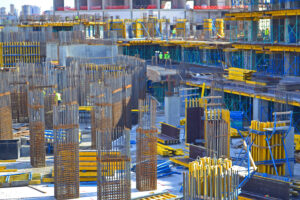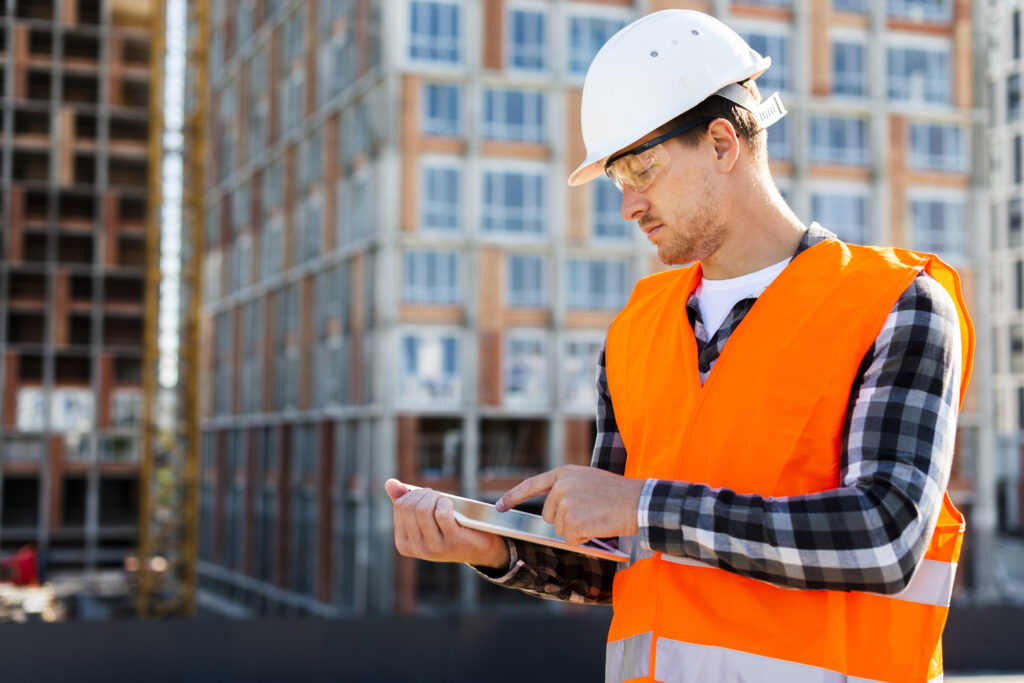In today’s dynamic construction landscape, staying ahead is essential for success. With project schedules becoming tighter and budget limitations increasing, many industry professionals are adopting innovative technologies to make their workflows more efficient. But what role does commercial construction technology actually play?
Commercial construction technology drives greater efficiency, safety, and productivity across building projects. This field encompasses a range of software, hardware, and digital tools that automate tasks, enhance communication, and deliver real-time data, all of which lead to more informed decision-making.
While this provides a general overview, it’s worthwhile to explore how specific advancements in commercial construction technology are transforming the industry. Let’s dive into how these tools are tackling common challenges and unlocking fresh opportunities for the future of commercial construction.

How Can Commercial Construction Technology Drive Project Efficiency?
In commercial construction, technology has become an essential tool in enhancing project efficiency, significantly impacting construction management processes. One key technology leading this transformation is Building Information Modeling (BIM). With BIM software, architects, engineers, and contractors can develop comprehensive 3D models of buildings before breaking ground. These detailed virtual models provide a clear picture of the project and allow early identification of potential clashes and issues, helping to minimize costly rework and avoid delays once construction begins.
Project management software is another valuable asset for increasing efficiency in commercial construction. These platforms centralize communication, facilitate document sharing, and streamline task management, ensuring all team members are aligned and informed. Real-time updates and notifications keep everyone up-to-date on project status, upcoming deadlines, and any changes to plans. This enhanced level of communication and coordination reduces downtime and significantly lowers the likelihood of errors related to miscommunication.
What Safety Innovations Does Modern Construction Technology Provide?
Ensuring safety on construction sites is essential, and recent advancements in technology have transformed safety protocols. Modern wearable technology, such as smart helmets and vests, now plays a critical role in monitoring workers’ health and safety. These wearables can track vital signs, detect falls, and alert supervisors to any risks. Additionally, they can monitor workers’ locations, allowing for prompt intervention in emergencies.
Drones have become vital tools in construction for conducting site inspections and overseeing safety measures. By accessing challenging or hazardous areas, drones capture high-resolution images and videos, enabling early detection of potential risks before they escalate. Furthermore, virtual reality (VR) training simulations provide workers with the chance to practice high-risk tasks in a secure, virtual environment, enhancing their skills and situational awareness without exposing them to real-life dangers.

How is Data Analytics Shaping the Future of Commercial Construction?
Data analytics is transforming how decisions are made in the commercial construction industry. By gathering and interpreting large volumes of data from sources like sensors, equipment, and project management platforms, construction companies can unlock critical insights about their projects. This data-driven methodology enhances cost estimation accuracy, optimizes resource distribution, and strengthens risk management strategies. Ultimately, these improvements directly benefit commercial clients by saving both time and money.
Moreover, predictive analytics empowers project managers to identify and address issues before they escalate. By examining past data alongside current project metrics, predictive models can anticipate delays or cost overruns, enabling proactive solutions.
Data analytics also plays a key role in refining equipment maintenance schedules, minimizing unexpected breakdowns and maximizing equipment efficiency. This not only contributes to cost and time savings but also enhances job site safety.
How Is Artificial Intelligence Transforming the Landscape of Commercial Construction?
Artificial Intelligence (AI) is revolutionizing the commercial construction industry, becoming an indispensable tool for contractors. A primary area where AI shines is design optimization. With advanced algorithms, AI can assess numerous design possibilities, taking into account elements like energy efficiency, budget constraints, and structural stability. This process not only accelerates the design phase but also fosters more creative and effective building solutions.
In addition to design, AI is reshaping project scheduling and resource management. AI-driven platforms can generate precise and adaptable schedules, with the capability to adjust timelines and resource distribution based on real-time updates. This dynamic approach empowers project managers to proactively address delays or resource shortages. Moreover, AI plays a critical role in quality assurance, analyzing site images and data to identify flaws or discrepancies in construction, ensuring that projects adhere to the highest standards.

How Is Mobile Technology Revolutionizing On-Site Operations?
Mobile technology is now essential for today’s construction industry, empowering job sites with the full range of digital tools and resources. Equipped with tablets and smartphones loaded with specialized construction applications, workers can instantly access vital project information, submit detailed reports, and communicate with team members in real-time. This level of connectivity and data accessibility significantly reduces delays caused by miscommunication or information gaps.
In addition to communication, mobile devices are integral to quality control and documentation processes. Construction teams can capture high-resolution photos and videos to document project progress, flag potential issues, or showcase completed work. These visual records are easily uploaded to project management platforms, keeping stakeholders up-to-date on the project’s latest status. Furthermore, mobile technology enables digital signatures and fast-tracked approvals, streamlining administrative tasks and cutting down on paper-based documentation. This not only accelerates processes but also fosters eco-friendly practices by reducing paper waste.
Revolutionary Technological Innovations in Commercial Construction
The commercial construction industry is on the brink of a technological revolution, with groundbreaking advancements reshaping how projects are planned, executed, and maintained:
Enhanced Building Information Modeling (BIM)
BIM technology has rapidly evolved from traditional 3D modeling to powerful multi-dimensional solutions:
- 5D BIM: Adds a new layer by incorporating scheduling (4D) and cost analysis (5D), enabling better project timelines and more accurate budget forecasts.
- Cloud-Based BIM: Offers real-time collaboration by connecting team members remotely, allowing seamless updates and adjustments from anywhere.
- BIM-to-Field: Merges BIM data with augmented reality (AR), empowering on-site workers to view digital models through mobile devices or AR glasses for accurate, real-world applications.
IoT Integration and Sensor Technology
IoT devices and smart sensors are turning job sites into highly connected and intelligent environments:
- Equipment Tracking: GPS-powered sensors keep tabs on machinery and tools, helping to optimize their usage and prevent downtime.
- Environmental Monitoring: Real-time sensors check air quality, noise levels, and more, ensuring the site meets regulatory standards and maintains a safe work environment.
- Structural Health Monitoring: Embedded sensors provide continuous feedback on structural conditions, allowing for preventative maintenance and increased longevity.
Robotics and Automation on Site
Automation and robotic technologies are revolutionizing job sites with faster, more precise building solutions:
- Bricklaying Robots: These advanced machines can lay bricks with higher precision and efficiency, accelerating the construction timeline.
- 3D Printing: Large-format 3D printers can now produce building elements and even entire structures, minimizing waste and lowering labor expenses.
- Drones: Beyond inspections, drones are performing site surveys, tracking project progress, and even transporting materials across the site.
Advanced Materials and Green Technologies
Innovations in materials science are contributing to more sustainable, resilient construction methods:
- Self-Healing Concrete: Embedded with bacteria, this innovative concrete automatically seals cracks, extending the lifespan of structures.
- Transparent Wood: An eco-friendly alternative to glass, transparent wood offers enhanced insulation properties and a distinctive visual appeal.
- Energy-Harvesting Buildings: By integrating photovoltaic materials into facades and windows, buildings can now generate renewable energy, promoting sustainability in urban areas.
These advancements mark a transformative era for commercial construction, making projects faster, safer, and more eco-friendly than ever.

The Influence of Cutting-Edge Technology on Commercial Construction
Emerging technological advancements are revolutionizing the commercial construction industry in multiple impactful ways:
- Boosted Efficiency: Automation, artificial intelligence, and sophisticated software solutions are refining workflows, shortening project durations, and reducing the likelihood of errors.
- Increased Safety Measures: VR training modules, IoT-enabled sensors, and AI-driven risk analysis are enhancing safety standards on construction sites.
- Eco-Friendly Focus: Innovative materials and intelligent systems are driving the shift towards energy-efficient and environmentally responsible buildings.
- Cost Savings: Although the upfront costs of new technology may be significant, the long-term gains—such as lower labor costs, decreased errors, and efficient resource allocation—offset these expenses.
- Advancement in Workforce Skills: The adoption of advanced technology is generating new job opportunities and necessitating the development of digital skills among construction professionals.
Advancing with Construction Technology
Now that the importance of commercial construction technology is clear, it’s time to make a decisive move. As a customer in the commercial construction space, your next step should be finding a construction partner that actively employs innovative technology to ensure exceptional project results.
In the rapidly evolving construction sector, selecting a partner who prioritizes advanced technology is no longer optional. It’s essential to remain competitive and attain the best possible outcomes for your commercial construction projects.
Conclusion
In the evolving landscape of commercial construction, technology has emerged as a transformative force, redefining project efficiency, safety standards, and environmental sustainability. The adoption of advanced tools—from BIM and AI-driven project management to mobile technology and IoT—has enabled construction professionals to tackle industry challenges with innovative solutions, optimizing project timelines and reducing operational costs. Safety innovations such as wearable technology and VR training are fostering safer job sites, while green technologies like energy-harvesting materials are contributing to more eco-conscious construction practices. As these technologies continue to evolve, they are not only enhancing the capabilities of the construction industry but also setting new standards for quality, safety, and sustainability. For stakeholders, partnering with technology-driven construction firms is essential to stay competitive and achieve exceptional project results. Embracing these advancements is key to driving the industry forward, meeting client expectations, and building a sustainable future.

